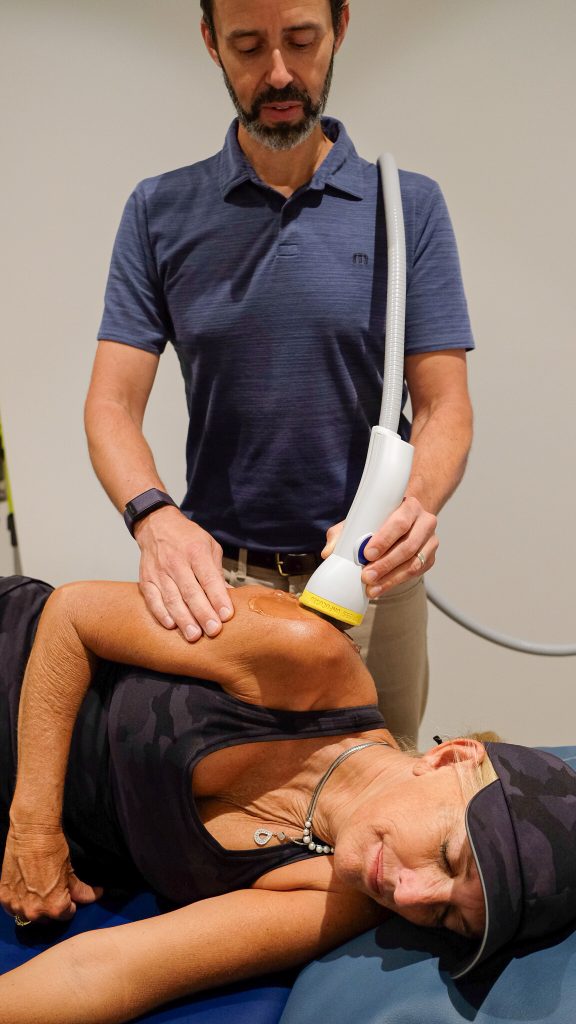Tennis is a sport that challenges nearly every part of the body. From explosive lateral movements to high-velocity swings, athletes are constantly pushing their joints, tendons, and muscles to perform under stress. Over time, this repetitive load—especially on the shoulders, elbows, knees, and ankles—can lead to breakdowns that limit performance or even sideline a player.
READ: Treating Hip Overuse Injuries in Tennis with SoftWave Technology
The sport also demands rapid acceleration, deceleration, and split-second changes in direction, which places strain on the lower body and core. Combine that with the high repetition of serves and groundstrokes, and it’s easy to see why tennis players are prone to chronic overuse injuries.
At Smart Athlete PT in Raleigh, our sports physical therapy team understands the unique movement patterns and injury risks that come with tennis. We don’t just treat symptoms—we help players build durability and resilience through targeted, evidence-based care.

What Is SoftWave Therapy and How Does It Work?
SoftWave Therapy is an advanced regenerative treatment that uses unfocused shockwaves to stimulate the body’s natural healing response. Unlike invasive procedures or medications that mask pain, SoftWave works at the cellular level—promoting tissue repair, reducing inflammation, and improving circulation in injured or overworked areas.
This non-invasive technology sends acoustic waves deep into soft tissue, triggering a biological response that recruits stem cells, increases blood flow, and breaks up scar tissue. For athletes, that means faster recovery, less downtime, and better long-term outcomes.
Tennis players in particular benefit from SoftWave’s ability to treat chronic tendon issues and joint pain—without the need for injections or surgery. It’s a safe, science-backed way to get your body moving better, without interrupting your training schedule.
READ: Tennis Elbow and SoftWave: A Modern Approach to Pain Relief
At Smart Athlete PT, SoftWave is often integrated into a comprehensive rehab and performance plan. It’s not just about healing tissue—it’s about helping you move and compete at your highest level.
Why Combine SoftWave with Sports Physical Therapy?
SoftWave therapy alone can promote healing, but when combined with sports physical therapy, the results go far beyond pain relief. At Smart Athlete PT, we use SoftWave as a powerful tool within a structured performance and recovery program—targeting both the symptoms and the underlying movement dysfunctions that caused the issue in the first place.
Here's how the combination works:
- SoftWave accelerates tissue regeneration, making it easier to restore mobility and reduce pain quickly.
- Sports physical therapy retrains the body’s movement patterns, correcting imbalances that lead to overuse or reinjury.
- Together, they help athletes return to sport faster—with better form, improved function, and less risk of recurrence.
For tennis players dealing with stubborn injuries like tendonitis or joint pain, this dual approach makes all the difference. SoftWave preps the tissue, while PT rebuilds the strength and control needed to withstand the demands of the court.
At Smart Athlete PT, this isn’t a one-size-fits-all solution—it’s a customized path designed to help you move, perform, and recover smarter.
Common Tennis Injuries Treated with SoftWave
Tennis players often face a range of repetitive stress injuries that can limit power, control, and mobility. SoftWave therapy is particularly effective for treating many of these common conditions by promoting deep tissue healing and reducing inflammation—without the need for rest alone or invasive procedures.
Here are some of the most frequent tennis-related injuries we treat with SoftWave at Smart Athlete PT:
- Tennis Elbow (Lateral Epicondylitis): Caused by overuse of the forearm muscles during gripping and swinging. SoftWave helps reduce tendon irritation and promotes repair.
- Rotator Cuff Strains: Overhead motions like serving can stress the shoulder’s stabilizing muscles. SoftWave aids in breaking up scar tissue and restoring mobility.
- Patellar Tendinopathy: Jumping and decelerating put strain on the front of the knee. SoftWave enhances blood flow and accelerates tissue recovery.
- Achilles Tendinopathy: Quick cuts and direction changes stress the calf and Achilles. SoftWave therapy supports faster healing and reduced stiffness.
- Hip or Lower Back Pain: Often tied to mobility deficits or muscular imbalances, SoftWave can be applied to deep tissue regions to relieve chronic tension and improve flexibility.
Whether you're recovering from injury or trying to stay one step ahead of it, SoftWave is an ideal addition to your rehab plan—especially when integrated with movement-focused sports physical therapy.
READ: Self-Assessment and Treatment of the Hip for Tennis Athletes
What to Expect from Treatment at Smart Athlete PT
At Smart Athlete PT, every tennis player begins with a detailed evaluation—not just of the injury, but of how your body moves as a whole. We assess joint mobility, strength, control, and sport-specific mechanics to understand what’s holding you back or causing repeated strain.
SoftWave therapy is then applied directly to the affected areas—typically lasting about 10–15 minutes per session. The treatment is non-invasive and requires no downtime, so you can stay active while your body begins the healing process.
Following SoftWave, your therapist will guide you through targeted sports physical therapy exercises focused on correcting movement imbalances, restoring strength, and rebuilding dynamic control for tennis-specific demands. From shoulder stability to core rotation to single-leg balance, every aspect of your rehab is purposeful.
Most importantly, you’ll receive a customized performance plan that supports both short-term recovery and long-term injury prevention—so you can return to the court stronger than when you left it.
